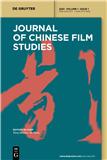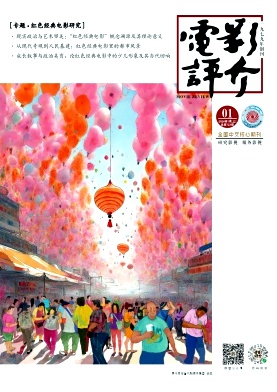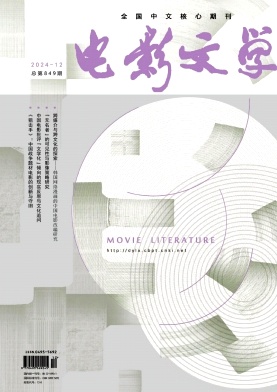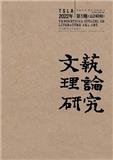
中国电影研究(英文)(Journal of Chinese Film Studies)(国际刊号) 知网目次
- AMI入库
- 主管单位:
- 主办单位:
- 国际刊号:
2702-2277;EISSN 2702-2285
- 国内刊号:
- 学科分类:
- 字数:
-
- 有无基金:
- 周期:
国际号刊
- 特殊属性:
外文期刊
- 电话:
- 邮箱:
jcfs@degruyter.com(官网邮箱)
- 复合因子:
0
- 综合因子:
0
- 收录:
知网目次
- 级别:
AMI入库
期刊简介
《中国电影研究》期刊已被查看: 次
更新频次
单位占比
一作占比
投稿指南
1、该刊只有国际刊号。
2、投稿方式:在线投稿。
3、官网网址:
https://www.degruyter.com/journal/key/JCFS/html
4、投稿系统:http://mc.manuscriptcentral.com/jcfs
5、期刊刊期:一年3期,每年4、8、12月出版。
2023年2月22日星期三
《中国电影研究》2023年全新改(扩)版
【微信公众号信息】
为顺应国内外学界研究需要,由国际知名出版社德古意特出版的国际学术期刊《中国电影研究》(ISSN 2702-2277)从2023年起将全新改(扩)版。扩版后的《中国电影研究》期刊将增加版面和内容,由一年两期改为一年三期,每期刊登10篇左右原创性论文、深度访谈和影评,每年4、8、12月官网在线与纸质期刊同步出版。欢迎学界同仁踊跃订阅、积极投稿!
有关投稿或订阅咨询,请联系本刊编辑部:jcfs@degruyter.com
期刊简介
Journal of Chinese Film Studies《中国电影研究》是第一本由中国学者担任主编的电影研究国际期刊,旨在建构一个开放的学术平台,汇聚全世界关注中国电影、研究中国电影的学者,以多元包容的学术态度,共同探讨中国电影的历史、现状和未来,推动用跨学科的方法研究中国电影的理论与美学、批评和实践,聚焦讨论中国电影的文化价值和艺术风格,融通国内外对于中国电影的学术研究。
Journal of Chinese Film Studies主要刊登原创性论文、深度访谈、书评和影评。为确保论文质量,本刊由国际化的编辑委员会和审稿专家进行双向匿名同行评议。
期刊官网:
https://www.degruyter.com/journal/key/JCFS/html
投稿网址:
http://mc.manuscriptcentral.com/jcfs
期刊编辑部:
jcfs@degruyter.com
《中国电影研究(英文)》征稿启事
【微信公众号“TCLR”信息】
JCFS Journal 2021-03-28
01 期刊简介
Journal of Chinese Film Studies(《中国电影研究》)是一本以中国电影为研究对象,面向全球学界的国际英文学术期刊,于2021年创刊,由国际著名学术出版社德古意特(De Gruyter)出版,北京电影学院王海洲教授和中国传媒大学金海娜教授担任主编。本刊为半年刊,以印刷版和电子版的方式全球同步发行。
Journal of Chinese Film Studies立足中国,面向国际,旨在搭建一流国际学术平台,发表国内外高水平的中国电影研究成果,加强不同文化背景的研究者之间的对话和沟通,促进国内外电影研究界开展交流与合作,推动中国电影研究的全球发展。本刊刊发有关中国电影各个方面的研究成果,包含但不限于中国电影的历史、产业、美学、创作、传播、接受等方面的理论研究与实证探析。鼓励不同学科领域的学者以多样的方法与丰富的视角开展中国电影研究,鼓励中外学者开展合作研究。
Journal of Chinese Film Studies主要刊登原创性论文、深度访谈、书评和影评。为确保论文质量,本刊由国际化的编辑委员会和审稿专家进行双向匿名同行评议。
02 期刊团队
主编
王海洲,电影学博士,北京电影学院教授,博士生导师。现任北京电影学院研究生院院长、图书馆馆长,未来影像高精尖创新中心艺术方向首席研究员、国家社科基金艺术学重大项目首席专家。
金海娜,中国传媒大学教授、博士生导师,国家社科基金重大项目“中国电影翻译通史”首席专家。
编辑委员会
Editor
蔡秀妆(Hsiu-chuang Deppman),欧柏林学院
方文莎(Vanessa Frangville),布鲁塞尔自由大学
符平,陶森大学
黄雪蕾,爱丁堡大学
李尚埈(Sangjoon Lee),南洋理工大学
李洁,哈佛大学
中岛圣雄(Seio Nakajima),早稻田大学
朴汉俊(Aaron Han Joon Magnan-Park),香港大学
任格雷(Gary Rawnsley),宁波诺丁汉大学
石峻山(Josh Stenberg),悉尼大学
菅原庆乃(Sugawara Yoshino),关西大学
顾问委员会
Adviser
裴开瑞(Chris Berry),伦敦国王学院
加里·贝廷森(Gary Bettinson),兰卡斯特大学
康浩(Paul Clark),奥克兰大学
大卫·德赛(David Desser),伊利诺伊大学
丁亚平,中国艺术研究院
汤姆·甘宁(Tom Gunning),芝加哥大学
何依霖(Margaret Hillenbrand),牛津大学
旷斯凡(Stefan Kramer),科隆大学
李道新,北京大学
毕克伟(Paul Pickowicz), 加利福尼亚大学圣地亚哥分校
肯延·托马塞利(Keyan Tomaselli),约翰内斯堡大学
王斑,斯坦福大学
03 来稿须知
欢迎各位专家、同仁惠赐稿件
1.本刊为线上投稿,同行评审。论文提交网址为:http://mc.manuscriptcentral.com/jcfs
2.来稿的学术论文长度应为6000-8000个英文单词(包括注释、参考文献等),书评和影评的长度不超过1500个英文单词,访谈的长度不超过3000个英文单词。文章摘要长度为100-150个英文单词,关键词3-5个。作者简介为100个英文单词以内。
3.来稿论文格式及参考文献格式请参考芝加哥author-date格式:https://www.chicagomanualofstyle.org/tools_citationguide/citation-guide-2.html
4.本刊为英文刊物。来稿请使用明晰且符合语法规则的英语。若作者不是英语母语人士,建议邀请母语人士进行论文语言修改和润色。
5.来稿使用word文档,字号使用Times New Roman 12号。全文使用双倍行距。若来稿包含特殊符号、表格或图表,请提供对应的PDF版本。文件请标注页码。参考文献另起一页。
6.稿件中的中文人名采用拼音,若有英文名字亦可使用,全文保持一致即可。
7.电影名和书名请用斜体。英文电影名称首次出现时,请在括号中标注上映年份,如Inception (2010)。非英文电影名称首次出现时,请在括号中标注其源语言名称及上映年份,如Farewell My Concubine (Bawang bieji,1993)。
8.本刊仅接收英文稿件,切勿一稿多投。
9.有关期刊及投稿等更多信息,请访问期刊官网:
https://www.degruyter.com/journal/key/JCFS/html
10.关于稿件和专刊建议,请联系本刊编辑部:jcfs@degruyter.com
《中国电影研究(英文)》作者须知
【官网信息】
INSTRUCTIONS FOR AUTHORS
Aims and Scope
Journal of Chinese Film Studies (JCFS) is a peer-reviewed scholarly journal which follows the development of Chinese film industries, discovers issues on the frontiers of academic inquiry, and provides a platform for cutting-edge academic results. It is committed to advancing interdisciplinary approaches to the criticism and analysis of Chinese films and cinematic practices across genres and platforms. The journal is open to all areas of scholarship in Chinese film studies, and presents academic work from multiple critical, cultural and theoretical perspectives.
The journal seeks original contributions that propose new ideas, pursue innovative research directions and methodologies, or engage with significant historiographical or interpretive issues regarding Chinese films in the mainland, Taiwan, Hong Kong, and diasporic communities. In addition, the journal welcomes reviews of significant books and films, as well as insightful interviews with filmmakers and film scholars. It publishes not only scholarly works in English, but also English translations of non-English-language research. It will showcase research both from established scholars and from emerging new voices of Chinese film studies. Authors are encouraged to submit video abstracts to accompany their articles after acceptance.
JCFS publishes articles in the following categories:
articles of original research
editorial
book review
film review
interview
Submission might include, but are not limited to the following fields:
Chinese film history
Chinese film industries
Auteurs in Chinese cinemas
Stardom in Chinese cinemas
Film genres of Chinese cinemas
Chinese cinematic practices
Chinese cinemas, culture, and society
Reception of Chinese cinemas
Multilingualism in Chinese cinemas
Gender/class/sexuality in Chinese cinemas
Chinese films on ethnic minorities
Transnational Chinese cinemas
Editorial Policy
Unpublished material
Authors submitting a paper do so on the understanding that the work has not been published before in English, is not being considered for publication elsewhere, and has been read and approved of by all its authors. Authors submitting papers for publication warrant that the work does not infringe on any existing copyright and indemnify the publisher against any such infringement.
Conflict of interest
For every submission to JCFS, authors have to fill out and upload the Author Form for Disclosure of Potential Conflict of Interest and the Template for Ethical and Legal Declarations at the time of the original submission.
Copyright
Manuscripts are accepted on condition of transfer of copyright (for U.S. government employees: to the extent transferable) to the publisher. Once the manuscript has been accepted, it may not be published elsewhere without the consent of the copyright holders.
Authorship
Authorship should be limited to those who have made a significant contribution to the conception, design, execution, or interpretation of the reported study. All those who have made significant contributions should be listed as co-authors. Where there are others who have participated in certain substantive aspects of the research project, they should be named in an Acknowledgement section.
Peer Review process
The journal uses double-blind peer review model. Each paper will be refereed by a minimum of two reviewers. The Editors reserve the right to decline the submitted manuscript without review, if the studies reported are not sufficiently novel or important to merit publication in the journal. Manuscripts deemed unsuitable (insufficient originality or of limited interest to the target audience) are returned to the author(s) without review. The Editor seeks advice from experts in the appropriate field. Authors may suggest persons competent to review their manuscript. However, please note that this will be treated only as a suggestion, and the final selection of reviewers is exclusively the Editor’s decision. The final decision of acceptance is made by the Editor-in-Chief.
Scientific Misconduct
This journal publishes only original manuscripts that are not also published or going to be published elsewhere. Multiple submissions/publications, or redundant publications (re-packaging in different words of data already published by the same authors) will be rejected. If they are detected only after publication, the journal reserves the right to publish a Retraction Note.
Electronic Submission
1. Editorial process
The editorial process will be administered by the web-based submission and peer-review program Scholar One. The journal’s submission site is http://mc.manuscriptcentral.com/jcfs
2. Length of papers
Journal of Chinese Film Studies publishes original, peer-reviewed scholarly articles, which should be 6,000–8,000 words in length (inclusive of the abstract, tables, references). Review essays should not exceed 1500 words. Interviews should not exceed 3000 words. Abstracts are limited to 100-150 words and three to five keywords. Manuscripts with multiple listed authors are reviewed on the assumption that all listed authors have agreed to the manuscript’s submission and are responsible for its content; they must have agreed to its publication and have given the corresponding author the authority to act on their behalf in all matters pertaining to publication. The corresponding author is responsible for informing the co-authors of the manuscript status throughout the submission, review, and production process.
3. Biographical note
Please supply short biographical notes (under 100 words) for each author.
4. Language
The language of publication is English. Any spelling style is acceptable so long as it is consistent within the manuscript. Papers submitted to JCFS must be written in clear, concise and grammatical English. If not written by a native speaker, it is advisable to have the paper checked by a native speaker.
5. Format
Please use Word. If you use any special characters, tables or figures, please supply a PDF file as well. Please number all pages consecutively. Please use font size Times New Roman 12 point and double line spacing throughout, quotations, notes and references included. Begin the References on a new page. Notes should be kept to a minimum.
6. References
Please use the Chicago Manual of Style author-date system for citation:
https://www.chicagomanualofstyle.org/tools_citationguide/citation-guide-2.html
7. Names
It is acceptable to use either Chinese pinyin or English names (if any) for any Chinese persons named in the article as long as the same name is used consistently throughout the article.
8. Film and media titles
When film or media titles are initially cited, please provide the release year in parentheses: e.g, Inception (2010). For non-English film and media titles, the English language title should come first, followed by the original title and the release year in parentheses: e.g, Farewell My Concubine (Bawang bieji, 1993).
Further Information
All correspondence concerning editorial matters, manuscripts, or proposals for special issues should be sent to the editorial office via: jcfs@degruyter.com
Publication Formats
Electronic Formats Allowed
We accept submission of text, tables and figures as separate files or as a composite file. For your initial submission, we recommend you upload your entire manuscript, including tables and figures, as a single PDF file. If you are invited to submit a revised manuscript, please provide us with individual files: an editable text and publication-quality figures.
Text files can be submitted in the following formats:
❖ MS Word – standard DOCUMENT (.DOC)
❖ PDF (not applicable for re-submitted or accepted manuscripts, see below).
Tables should be submitted as MS Word or PDF (not applicable for re-submitted or accepted manuscripts, see below). Please note that a straight Excel file is not an acceptable format.
Graphics files can be submitted in any of the following graphic formats: EPS; BMP; JPG; TIFF; GIF or PDF. Please note that Powerpoint files are not accepted.
Post-acceptance, text files of the revised manuscript and tables are required for use in production. Authors should clearly indicate the location(s) of tables and figures in the text if these elements are given separately or at the end of the manuscript. If this information is not provided to the editorial office, we will assume that they should be placed at the end of the text.
First-time Submission of Manuscripts
Authors may include a cover letter with their manuscript. If so, please explain why you consider your manuscript to be suitable for publication in Journal of Chinese Film Studies, why your paper will inspire the other members of your field, and how it will drive academic discussion forward.
Submission of Revised Articles
Resubmitted manuscripts should be accompanied by a letter outlining a point-by-point response to Editor’s and reviewers’ comments and detailing the changes made to the manuscript. A copy of the original manuscript should be included for comparison if the Editor requests one. Please return the revised article within the required timeframe.
For resubmitted manuscripts, please provide us with an editable text and publication-quality figures. Supply any figures as separate high-resolution, print-ready digital versions.
In addition to the editorial remarks, authors are asked to take care that they have prepared the revised version according to the Journal’s style.
Organization of the Manuscript
We would like to stress the importance of carefully preparing the title, keywords and abstract, as these elements are used by bibliographic databases and search engines to identify the content of the manuscript.
Title
A title should be informative, specific to the project, and yet concise. Please bear in mind that a title that is comprehensible to a broad academic audience and readers outside your field will attract a wider readership. Avoid specialist abbreviations and non-standard acronyms. Titles should be presented in sentence, not title case (i.e., only the first word should be capitalized). Please also provide a brief "running title" of not more than 50 characters.
Authors, Affiliations, Addresses
In the cover letter, provide the first names (or initials – if used), middle names (or initials – if used), and surnames for all authors. Affiliations should include:
Department
University or organization
City
Postal code
State/province (if applicable)
Country
One of the authors should be designated as the corresponding author to whom inquiries regarding the paper should be directed. It is the corresponding author’s responsibility to ensure that the author list and the summary of the author contributions to the study are accurate and complete.
Abstract
Abstracts are limited to 100-150 words. The abstract should give a summary of the content of the paper. Mention the main findings without going into methodological detail and summarize briefly the most important elements of the paper. Because the abstract will be published separately by abstracting services, it must be complete and understandable without reference to the text.
Keywords
List keywords for the work presented (minimal of 3, and maximum of 5), separated by commas. Keywords should not replicate those used in the title.
Formatting and Typesetting
All pages must be numbered consecutively. The whole text (including legends, footnotes, and references) should be formatted double-spaced with no hyphenation and automatic word-wrap (no hard returns within paragraphs). Please type your text consistently, e.g. take care to distinguish between ‘1’ (one), ‘I’ (capital I) and ‘l’ (lower-case L) and ‘0’ (zero) and ‘O’ (capital O), etc. Manuscript pages should have line numbers. The font size should be no smaller than 12 points.
Footnotes and endnotes should be avoided. Allowable footnotes/endnotes may include: the designation of the corresponding author of the paper, the current address of an author (if different from that shown in the affiliation), abbreviations and acronyms.
Symbols and abbreviations
The use of special symbols, abbreviations, and acronyms is permitted so long as they are defined upon first mention in the article.
Other Stylistic Points:
Bold is restricted to essay titles and subheadings.
Subheadings should have an initial capital for each major word and are not numbered.
Italics are used for titles of books, journals, newspapers, films, plays, etc.
Dashes: Unspaced dashes—are used for parenthetical comments.
Dates in the body of the text: February 18, 2011.
Foreign language words or phrases: accompanied by a translation in square brackets.
Numbers that begin a sentence are spelt out (e.g. Eighty percent).
Percent: written as % but spelt out at the beginning of a sentence.
Numbers of centuries are spelt out (e.g. twentieth century)
The elision of numbers: we use 135-136, not 135-36.
The omission of text: shown by an ellipsis. The form is . . . with a character space on either side. If sentence ends before the ellipsis, a full stop follows it without space. . . . Then the rest of the ellipsis is spaced as already stated. If the ellipsis is in the original, please use unspaced full stops …
Quotation marks: we use double curly quotation marks. Single quotation marks are used only for quotes within quotes.
Commas and periods that directly follow quotations go inside the closing quotation marks. All other punctuation marks—such as semicolons, colons, question marks, and exclamation points—go outside a closing quotation mark, except when they are part of the quoted material.
We use English spellings for foreign geographical names (i.e. Copenhagen, not København).
Outline of the Production Process
Once an article has been accepted for publication, the manuscript files are transferred into our production system to be formatted. Technical editors reserve the privilege of editing manuscripts to conform to the stylistic conventions of the journal. Once the article has been typeset, PDF proofs are generated so that authors can approve all editing and layout.
Immediate Publication
Manuscripts ready for publication are promptly posted online. The manuscripts are considered to be ready for publication when the final proofreading has been performed by authors, and all concerns have been resolved. Please note that no changes can be made to the articles after online publication.
上一篇:传感器技术与应用(OA学术期刊)下一篇:今传媒
常见问题
-
中国电影研究杂志社官网、联系方式是什么?
中国电影研究杂志社官网:https://www.degruyter.com/journal/key/jcfs/html
投稿网址:http://mc.manuscriptcentral.com/jcfs
投稿邮箱:jcfs@degruyter.com(官网邮箱) -
中国电影研究杂志是核心期刊么?
中国电影研究是核心期刊,级别是:AMI入库, 是:艺术分类下的知网目次收录的期刊。
-
请问你们是中国电影研究杂志社吗?
我们不是《中国电影研究》杂志社。本站主要从事期刊信息展示与期刊推荐,不是任何杂志官网,直投稿件请联系杂志社。本站仅提供免费的学术指导、论文辅导、期刊投稿信息整理收集服务。
-
你们指导服务后可以保证文章被发表吗?
期刊发表的成功与否,主要取决于文章内容的质量。编辑老师会根据研究领域、创新性等多因素进行考量。我们会帮助您理解期刊的发表要求,助力提升发表几率,从而增加发表的机会。
-
晋级论文能否在报纸上发表?
在学术界,论文的发表往往被视为研究者职业发展的重要一环。晋级论文,即为了获得更高职称或学术地位而撰写的学术论文,通常需在专业期刊上发表。然而,许多人可能会问








